AP Physics - Dynamics Multiple Choice
1/67
Earn XP
Description and Tags
made from the multiple choice packet given by my teacher. includes questions about Newton's 3 Laws, Mass, weight, and normal force, Free Body Diagrams, Friction, Tension, and Springs :)
Name | Mastery | Learn | Test | Matching | Spaced |
|---|
No study sessions yet.
68 Terms
1. In the absence of a net force, a moving object will _____.
A. slow down and eventually stop
B. stop immediately
C. turn right
D. move with constant velocity
D
2. When a cat sleeps on a table, the net force on it is _____.
A. zero
B. directed upward
C. directed downward
D. directed in the horizontal direction
A
3. When the engines on a rocket ship in deep space, far from any other objects, are turned off, it will _____.
A. slow down and eventually stop
B. stop immediately
C. turn right
D. move with constant velocity
D
4. For a rocket ship in deep space, far from any other objects, to move in a straight line with constant speed it must exert a net force that is _____.
A. proportional to its mass
B. proportional to its weight
C. proportional to its velocity
D. zero
D
5. If a book on the dashboard of your car suddenly flies towards you, the forward velocity of the car must have _____.
A. decreased
B. increased
C. changed direction to the right
D. become zero
B
6. A spacecraft travels at a constant velocity in empty space far away from any center of gravity. Which of the following about the force applied on the spacecraft is true?
A. The applied force is equal to its weight.
B. The applied force is slightly greater than its weight.
C. The applied force is slightly less than its weight.
D. No applied force is required to maintain a constant velocity.
D
7. A boy rides a bicycle at a constant velocity. Which of the following about the net force is true?
A. There is a net force acting in the direction of its motion.
B. There is a net force acting opposite to the direction of its motion.
C. The net force is zero.
D. There is a net force acting perpendicularly to the velocity direction.
C
8. A passenger standing in a moving bus, facing forward, suddenly falls forward. This can be an indication which of the following?
A. The bus speeds up.
B. The bus slows down.
C. The bus doesn’t change its
velocity.
D. The bus turns to the right.
B
9. A passenger standing in a moving bus, facing forward, suddenly falls backward. This can be an indication which of the following?
A. The bus speeds up.
B. The bus slows down.
C. The bus doesn’t change its velocity.
D. The bus turns to the right.
A
10.A passenger standing in a moving bus, facing forward suddenly falls to the right. This can be an indication which of the following?
A. The bus speeds up.
B. The bus slows down.
C. The bus turns to the left.
D. The bus turns to the right.
C
11.The acceleration of an object is directly proportional to _____.
A. the net force acting on it
B. its position
C. its velocity
D. its mass
A
12.The acceleration of an object is inversely proportional to _____.
A. the net force acting on it
B. its position
C. its velocity
D. its mass
D
13.A net force F accelerates a mass, m, with an acceleration, a. If the same net force is applied to a mass, 5m, then the acceleration will be _____.
A. 5a
B. 25a
C. a/5
D. a/25
C
14.A net force F acts on a mass, m, and produces an acceleration, a. What acceleration results if a net force, 3F, acts on a mass, 6m?
A. a/2
B. 8a
C. 4a
D. 2a
A

As shown in the figure, two boxes of masses m and 4m are in contact with each other on a frictionless surface. What is the acceleration of the more massive box when the system of the two blocks is acted on by force, F?
A. F/m
B. F/(2m)
C. F/(4m)
D. F/(5m)
D

As shown in the diagram, two blocks A and B with masses m and 2m are in contact on a horizontal frictionless surface. A force, F, is applied to block A. What is the acceleration of the system of two blocks?
A. F/m
B. F/2m
C. F/3m
D. F/4m
C
17.Mass and weight both _____.
A. have the same units of measurement
B. have different units of measurement
C. represent the force of gravity
D. represent the measure of inertia
B
18.The acceleration due to gravity is higher on Jupiter than on Earth. The mass and weight of a rock on Jupiter compared to that on Earth would be _____.
A. same, more
B. same, less
C. more, more
D. more, less
A
19.A ball is thrown straight up. At the top of its path, the magnitude of the net force acting on it is _____.
A. less than zero
B. between zero and mg
C. equal to mg
D. greater than mg
C
20.A hammer and a pebble are dropped simultaneously from the same height. Neglecting air resistance, _____.
A. the hammer accelerates faster because it is heavier
B. the hammer accelerates slower because it has more inertia
C. the pebble accelerates faster because it has a smaller mass
D. they both accelerate at the same rate
D
21.A boy stands in an accelerating elevator. What is the ratio between the apparent and regular weight of the boy, if the acceleration is 1⁄4 g?
A. 5/4
B. 4/5
C. 1/4
D. 4
A
22.An Olympic diver standing at the edge of a diving board squats down and then quickly stretches up before leaping of the board. How does the weight of the diver change while she is in contact with the board?
A. increases on the way down and then decreases on a way up
B. decreases on the way down and then increases on a way up
C. stays unchanged
D. increases on a way down and up
A
23.Which Newton’s law best explains the following statement that we often see on highway signs: “Buckle up – it’s the State Law”?
A. Newton’s first law
B. Newton’s second law
C. Newton’s third law
D. gravitational law
A
24.A loaded truck collides with a car causing huge damage to the car. Which of the following is true about the collision?
A. The force on the truck is greater than the force on the car.
B. The force on the car is greater than the force on the truck.
C. The force on the truck is the same in magnitude as the force on the car.
D. During the collision the truck undergoes a greater displacement than the
car.
C
25.When a baseball is struck by a bat, the force of the bat on the ball is equal and opposite to the force of the ball on the bat. This is an example of _____.
A. Newton's first law
B. Newton's second law
C. Newton's third law
D. Newton's law of gravitation
C
26.If you exert a force F on an object which has a much greater mass than you do, the force which the object exerts on you will have a magnitude _____.
A. F, and in the same direction
B. F, and in the opposite direction
C. much less than F
D. much greater than F
B
27.Newton’s third law refers to action-reaction forces. These forces always occur in pairs and _____.
A. sometimes act on the same object
B. always act on the same object
C. always act at right angles
D. never act on the same object
D
28.Action-reaction forces are _____.
A. equal in magnitude and point in the same direction
B. equal in magnitude and point in the opposite direction
C. unequal in magnitude but point in the same direction
D. unequal in magnitude and point in the opposite direction
B
29.A car traveling at 40 m/s strikes a mosquito. Which of the following is a true statement?
A. The force on the mosquito is greater than the force on the car.
B. The force on the mosquito is equal to the force on the car.
C. The force on the mosquito is smaller than the force on the car.
D. The damage to the mosquito is equal to the damage to the car.
B
30.The Earth pulls down on a railroad wagon with a force of 200 kN. Which of the following is the reaction force?
A. The wagon pulls up on the Earth with 200 kN.
B. The wagon pushes down on the tracks with
200 kN.
C. The railroad pushes up the wagon with 200 kN.
D. The buoyant force pushes up the wagon with 200 kN.
A
31.A railroad wagon pushes down on railroad tracks with a force of 200 kN. Which of the following is the reaction force?
A. The wagon pulls up on the Earth with 200 kN.
B. The wagon pushes down on the tracks
with 200 kN.
C. The tracks pushes up the wagon with 200 kN.
D. The buoyant force pushes up the wagon
with 200 kN.
C
Earth pulls downward on a pen, of mass m, which is sitting on a table; the magnitude of the force is mg. If that is called the action force, what is the reaction force?
A. The table pushing up on the pen with a force equal to mg.
B. The pen pushing down on the table with a force equal to mg.
C. The table pushing down on the floor with a force equal to mg.
D. The pen pulling upward on the Earth with a force equal to mg.
D
33.A traffic light is suspended from a cable. The Earth pulls downward on the traffic light with a force of 1500 N. If this is the action force, what is the reaction force?
A. The cable pulls upward on the traffic light with a 1500 N force.
B. The traffic light pulls downward on the cable with a 1500 N force.
C. The traffic light pulls upward on the Earth with a 1500 N force.
D. The Earth pulls downward on the cable with a 1500 N force.
C
34.A soccer player kicks a soccer ball with a force of 1300 N. The soccer ball hits the player with a force of _____.
A. less than 1300 N
B. exactly 1300 N
C. more than 1300 N
D. 0 N
B
35.A locomotive is pulling an empty freight car with constant acceleration on a horizontal surface. The mass of the locomotive is five times the mass of the car. Which statement is true about the force applied by the car on the locomotive?
A. It is five times greater than the force of the locomotive on the car.
B. It is five times less than the force of the locomotive on the car.
C. It is zero since they move with a constant acceleration.
D. It is equal to the force of the locomotive on the car.
D
36.A small box with an apple of mass m inside is thrown straight up. How does the force applied by the apple on the box change as they move up and then down? Ignore air resistance.
Moving Up, Apex, Moving Down
A. Greater than mg, No change, Less than mg
B. No change, No change, No change
C. Less than mg, Less than mg, Less then mg
D. Greater than mg, Greater than mg, Greater than mg
B
37.Which of the following is an example of a force which acts at a distance (without contact)?
A. tension
B. gravity
C. static friction
D. kinetic friction
B

As shown in the figure, two boxes of masses m and 4m are in contact with each other on a frictionless surface. What is the magnitude of the force causing the acceleration of the more massive box when the system of the two blocks is acted on by force, F?
A. 4F
B. 3F/2
C. 5F/4
D. 4F/5
D

As shown in the diagram, two blocks A and B with masses, m and 2m, are in contact on a horizontal frictionless surface. A force, F, is applied to block A. What is the force exerted by block A on block B?
A. F/2
B. F/3
C. 3F/2
D. 2F/3
D
40.What is the apparent weight of a 90 kg astronaut inside of a rocket accelerating from the surface of the Earth at 5 times the acceleration due to gravity?
A. 90 N
B. 900 N
C. 3600 N
D. 5400 N
D

41.Two blocks, A and B, are accelerated on a frictionless horizontal surface by an applied force F. What force does block A exert on block B as they accelerate to the right?
A. (3/5)F
B. (5/6)F
C. (6/5)F
D. (5/3)F
B
42.Which force is directly responsible for your ability to walk, and to stop?
A. weight
B. kinetic friction
C. static friction
D. tension force
C
43.Why is it more difficult to get a heavy table to start moving, than it is to keep it moving?
A. the normal force is greater for objects at rest
B. μs < μk
C. μs = μk
D. μs > μk
D
44.A horizontal force is exerted on an object so that it accelerates at a constant rate across a rough horizontal surface (friction cannot be neglected). The applied force is then doubled, causing the object’s acceleration to increase _____.
A. more than double its original value.
B. exactly double its original value.
C. less than double its original value.
D. at a rate equal to the new applied force divided by the object’s mass
A
45.A box is being pushed by a constant force along a horizontal surface. If the object’s velocity is constant, we can infer that there is _____ acting on the box.
A. a frictional force
B. a net downward force
C. no frictional force
D. a net force upward
A
46.A block with initial velocity of 3 m/s slides 9 m across a rough horizontal surface before coming to rest. What is the coefficient of kinetic friction?
A. 0.10
B. 0.50
C. 0.30
D. 0.05
D
47.A toolbox remains at rest in the middle of the bed of a pick-up truck that accelerates on a horizontal road. What force is responsible for the box’s acceleration?
A. the normal force of the truck on the box
B. the normal force of the box on the truck
C. the static friction of the truck on the box
D. the static friction of the box on the truck
C

48.Block A is placed on the top of Block B. The coefficient of static friction between the blocks is μ. Block B is pulled across a horizontal frictionless tabletop with a force, F. What is the minimum force, F, required to make block A slip off block B?
A. F = μg(mA − mB)
B. F = 2μgmA
C. F = μg(mA + mB)
D. F = 2μgmB
C

49.Block A is placed on the top of Block B, while Block B rests on a frictionless horizontal tabletop. The coefficient of static friction between the blocks is μ. What minimum force F must be applied to block A to cause it to slip off block B?
A. F = μmAg(1 +mA/mB)
B. F = μmAg(1 −mA/mB)
C. F = μg(1 +mA/mB)
D. F = μmAg(2 +mA/mB)
A
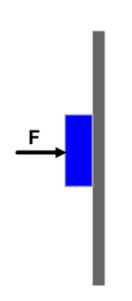
50.A student holds a physics book of mass m against the vertical wall by applying a horizontal force, F. The coefficient of static friction between the book and the wall is μ. What is the minimum force, F, that the student must exert on the book to prevent it from sliding down?
A. F = μmg
B. F = mg
C. F =μ/mg
D. F =mg/μ
D
51.A school bus, initially at rest, accelerates at a constant rate. A piece of paper is caught by the front side of the bus. The coefficient of static friction between the paper and the bus is μ. What is the minimum acceleration of the bus necessary to keep the piece of paper in place?
A. a = μg
B. a =μ/g
C. a =g/μ
D. a = g
C
52.An object is thrown straight up in the presence of air resistance. Which of the following is true when the object reaches its maximum height?
A. The gravitational force is zero.
B. The air resistance force is zero.
C. The gravitational force is less than the air resistance force.
D. The gravitational force is equal to the air resistance force.
B
53.An object of mass m is dropped near the surface of Earth and after some time reaches its terminal velocity. As it falls, the air resistance force is F = - kv, (upward) where k is a constant and v is the velocity of the object. What is the value of the terminal velocity of the object?
A. v =mg/k
B. v =m/kg
C. v =g/km
D. v =k/mg
A
54.An apple is thrown straight up and is affected by air resistance. How would you compare the magnitude of the acceleration of the apple with g – acceleration due to gravity – for the flowing cases?
Moving up, Apex, Moving Down
A. Greater than g, Equals g, Less than g
B. Less than g, Zero, Greater than g
C. Zero, Zero, Zero
D. Zero, Less than g, Greater than g
A
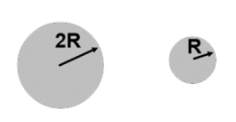
55.Two spheres made of the same material with radii of 2R and R are falling in the presence of air resistance. The force of air resistance, FR, is given by the relationship FR = - kv, where v is the velocity of the sphere. k is the coefficient of air resistance and is directly proportional to the radius squared of a sphere. Whatis the ratio of the terminal velocity of the large sphere to that of the small sphere?
A. 2/1
B. 1/2
C. 1/1
D. √2/1
A
56.An elevator of mass, M, is pulled upwards at constant velocity by a cable. What is the tension in the cable (neglecting the mass of the cable)?
A. less than zero
B. between zero and Mg
C. equal to Mg
D. greater than Mg
C
57.An elevator of mass M is pulled upwards by a cable; the elevator has a positive, but decreasing, velocity. What is the tension in the cable (neglecting the mass of the cable)?
A. less than zero
B. between zero and Mg
C. equal to Mg
D. greater than Mg
B
58.An elevator of mass, M, is pulled upwards by a cable; the elevator has a positive, increasing, velocity. What is the tension in the cable (neglecting the mass of the cable)?
A. less than zero
B. between zero and Mg
C. equal to Mg
D. greater than Mg
D
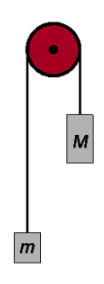
In the Atwood machine shown on the diagram, two masses, M, and m, are suspended from the pulley. What is the magnitude of the acceleration of the system? (Ignore friction and the mass of the pulley and M > m.)
A. (M−m)g/M+m
B. (M−m)g/M−m
C. (M+m)g/M+m
D. (M−m)g/2M
A
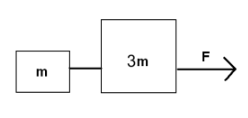
As shown in the figure, two boxes of masses, m and 3m, are connected by a string while a force, F, is pulling on the more massive box. What is the acceleration of the less massive box?
A. F/m
B. F/(2m)
C. F/(4m)
D. F/(5m)
C
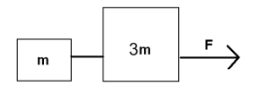
As shown in the figure, two boxes of masses, m and 3m, are connected by a string while a force F is pulling on the more massive box. What is the tension force in the string between the boxes?
A. F/m
B. F/2
C. F/4
D. F/5
C

62.A system of two blocks is accelerated by an applied force of magnitude, F, on the frictionless horizontal surface. The tension in the string between the blocks is
_____.
A. 3F
B. 5F
C. 3/8 F
D. 1/3 F
C
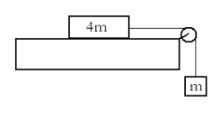
63.A block of mass, 4m, moves without friction on a horizontal table. The block is attached to another block of mass, m, by a string that passes over a frictionless pulley. If the masses of the string and the pulley are negligible, what is the magnitude of the acceleration of the descending block?
A. g/5
B. g/4
C. g/3
D. 2g/3
A
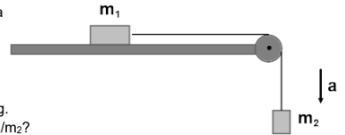
64.A block of mass, m1, is placed on the top of a horizontal table and connected to a hanging block, m2, by a light string that passes over a frictionless massless pulley. When the system is released from rest the hanging block accelerates downward at a constant rate of a = 1⁄4 g. What is the ratio of the two masses m1/m2? Ignore friction on the surface and the pulley.
A. 1/4
B. 1/3
C. 1/1
D. 3/1
D

65.Two Blocks A and B are pulled on a horizontal frictionless table by an applied force F. What is the net force on block A in terms of F?
A. F
B. (2/7)F
C. (1/7)F
D. (2/5)F
B

66.Two blocks are attached by a compressed spring and are initially held at rest on a frictionless surface. The blocks are then released simultaneously. If block I has four times the mass of block II, which of the following quantities is the same for both blocks as the spring pushes the two blocks away from each other?
A. force on each block
B. velocity
C. acceleration
D. displacement
A
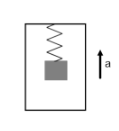
67.A block of mass, m, is attached to the elevator ceiling by a spring with a spring constant, k. The elevator accelerates upward at a constant rate, a. What is the change in the length of the spring?
A. x =m(g−a)/k
B. x =m(g+a)/k
C. x =mg/k
D. x =ma/k
B
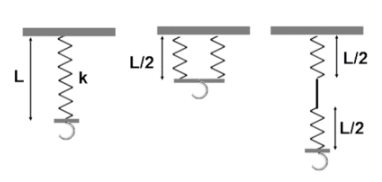
68.An elastic spring of length L and spring constant k is cut in half. First the new springs are connected in parallel and then in series. Which of the following is correct about the equivalent spring constant for each combination?
Parallel, Series
A. k ,2k
B. 2k, 1⁄2 k
C. 4k, k
D. 1⁄2 k, 2k
C